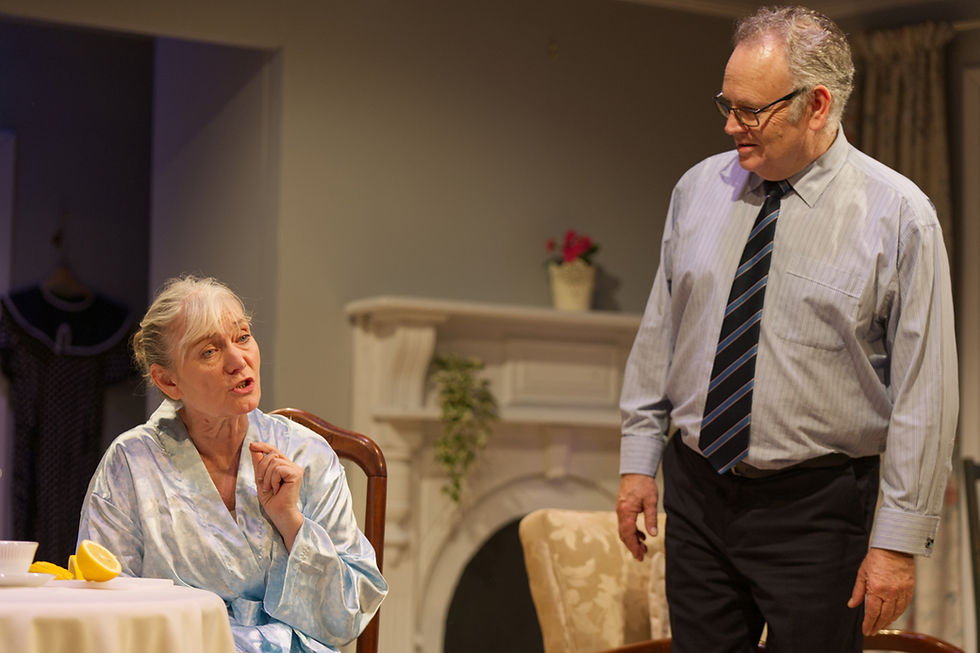Sweeney Todd - Garrick Theatre
- Kate O'Sullivan
- Jun 9
- 4 min read
Reviewed by Jordan D'Arcy
Sweeney Todd is a well-known Sondheim musical, popularised by the Tim Burton movie released in 2007. There are many versions of the story – the character originally appeared in the penny dreadful series "String of Pearls" in the mid-1800s, and in fact, appears even in Australian literature (namely, "The Man from Ironbark" by Banjo Patterson). There are rumours that have been circulating since the 1850s, suggesting that Sweeney Todd was, in fact, a real-life murderous barber.
This production appears to have taken significant inspiration from the Tim Burton adaptation. My understanding is that a significant casting update was made about three weeks before opening night, including the actors for Sweeney (Mark Thompson), Judge Turpin (Peter ‘Pear’ Carr), and half the ensemble. I appreciate that it must have been an enormous effort to prepare under such short notice, but unfortunately, with such extreme casting changes made so close to opening night, this show felt very under-rehearsed.
There were some beautiful voices on stage – in particular Mark Thompson as Sweeney Todd and Grace Edwards as Beggar Woman/Lucy Barker. Lily Wakeling also had the opportunity to show off her stunning and impressive soprano range as Johanna. Nera Camponovo as Pirelli was excellent and an absolute audience favourite. Another stand out was Corban Featon as Tobias who provided a much softer presence and nailed "Not While I’m Around".
The lighting design by Mark Nicholson was fun and included lighting the aisle for the more interactive parts of the show. There were some opening night issues. The cast dealt really well with a show stop in the first couple of minutes (the lights were not working) and maintained an excellent level of professionalism during both the stop and the restart of the run.
While I understand it is frustrating that this is brought up in every review, having both been on the Garrick stage and directed at Garrick myself, the stage is tiny and there were too many ensemble members for the space. This particular musical is not suited to the space and the resources available clearly did not give the cast opportunities to shine. The story is based on a serial killer, and we see the murders happen on stage. In many productions, there is a mechanism in which the barber chair is on a platform that allows the actor to drop through a trapdoor as if down into the incinerator. This production also did not think through adequately how to get around the issue of having to quickly get fake dead bodies off the stage. The actors being murdered had to get themselves from the chair to a wing about 3 feet away and then came back on in the same clothes seconds later to be murdered again. I felt that there was a lot of nuance missed from a directorial standpoint – the reason Sweeney and Mrs Lovett get away with their scheme for so long is that the whole charade of going to the barber for a shave is held up sometimes and customers are murdered other times, but there was no lead up to anything; no shaving cream or pretend cologne or a drop sheet or anything to indicate there was going to be a real shave at any point, including for instances where the customer was let go alive. More importantly, there was no blood.
This production used backing tracks and did not mic the cast. The benefit of the small size of the Garrick Theatre stage and auditorium is that we could adequately hear the cast and the backing track. It did seem like, when more than one person was singing, the cast was struggling to hear the music. Also, in Sondheim, the entire story is told through the lyrics of each song. The diction was lacking in a lot of songs, and in many places, the vibrato of certain voices (impressive as it was) made it impossible to distinguish the words.
With an ensemble of the size this show had I was surprised to see stagehands moving props and set pieces – there was the perfect opportunity to have cast members move these, particularly in big chunks of the show where they were not on stage.
There is a small warning on the front of the program that indicates themes of violence and sexual assault. This is appropriate given the content of the show. However, there was also a moment at the beginning of Act Two where I nearly had to walk out due to the level of repetitive noise – which I have never done before. The asylum scene is not something I remembered with any clarity from any other production, and upon researching I realised why. It is a scene with the sole purpose of showing how Johanna is rescued from Judge Turpin, and so is normally very minimal and done mostly with costume and a change in light. This production chose shock value over the storyline, as there were about 3 straight minutes of screaming and repetitive loud knocking sounds to simulate an asylum. There is nothing wrong with making a creative choice in a production that is designed to make the audience uncomfortable, but there needs to be some thought behind it – and if it is going to include loud, repetitive noises it needs to have a warning somewhere.
I feel that this production perhaps needed another eye on the production team in the form of a mentor or dramaturg. I got the impression that the cast was enjoying being on stage, if a little nervous for opening night, and ultimately, that’s what matters in community theatre.

Reviewer note: Jordan has previously performed at and directed at Garrick Theatre. She has also worked on stage with a couple of members of the cast. Tickets for this review were provided by the theatre company.






Comments